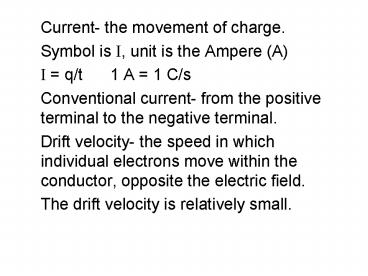Current- the movement of charge. PowerPoint PPT Presentation
Title: Current- the movement of charge.
1
- Current- the movement of charge.
- Symbol is I, unit is the Ampere (A)
- I q/t 1 A 1 C/s
- Conventional current- from the positive terminal
to the negative terminal. - Drift velocity- the speed in which individual
electrons move within the conductor, opposite the
electric field. - The drift velocity is relatively small.
2
- Resistance- the opposition to the flow of charge
by a material or device. - Symbol is R, unit is ohms (W).
- Ohms law R V/I or V IR
- Resistance depends on the following factors
- Length short wires have less resistance
- Area- thick wires have less resistance
- Material- different materials have different
conductivity of charge - Temperature- heat slows the flow of charge.
3
Power
- Power is energy used per time.
- The unit of power is a Watt Joule/sec
- P PE/t, or PIV
- You can use Ohms Law to substitute in the
equation, creating two other equations, PI2R, or
PV2/R.
4
Series Circuits
- In a series circuit, there is only one pathway
for current, so the current is the same
everywhere. - Resistors add up in series. RRRRtotal
- Kirchhoffs rule- Voltage drops must equal the
starting voltage, or V-IR-IR0. - Ohms Law holds for all parts of the circuit.
5
Advantages/Disadvantages
- Advantages of a Series Circuit- easy to hook up,
needs fewer wires, the current is the same
everywhere. - Disadvantages- uses more current, if one device
goes out, or a wire comes loose, the whole
circuit stops working.
6
Parallel Circuits
- In a parallel circuit, there are multiple
pathways for current. - Resistance in parallel is less than the smallest
parallel branch. - 1/R 1/R 1/Rtotal
- Voltage is the same across both branches.
- Current divides up in parallel, path of least
resistance gets more current. V/RI
7
Advantages/Disadvantages
- Advantages of Parallel- the resistance is lower,
more current can be used effectively, more
devices can be hooked into the same voltage
source. If one device goes out, the others
continue working. - Disadvantages of Parallel- more difficult to
connect, uses more wires.
PowerShow.com is a leading presentation sharing website. It has millions of presentations already uploaded and available with 1,000s more being uploaded by its users every day. Whatever your area of interest, here you’ll be able to find and view presentations you’ll love and possibly download. And, best of all, it is completely free and easy to use.
You might even have a presentation you’d like to share with others. If so, just upload it to PowerShow.com. We’ll convert it to an HTML5 slideshow that includes all the media types you’ve already added: audio, video, music, pictures, animations and transition effects. Then you can share it with your target audience as well as PowerShow.com’s millions of monthly visitors. And, again, it’s all free.
About the Developers
PowerShow.com is brought to you by CrystalGraphics, the award-winning developer and market-leading publisher of rich-media enhancement products for presentations. Our product offerings include millions of PowerPoint templates, diagrams, animated 3D characters and more.

